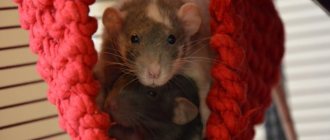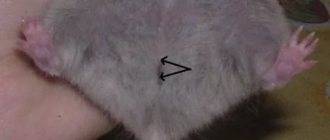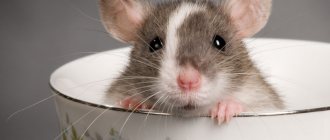Rats are the most common members of the mouse family on the planet. More than 60 species of rodents belonging to this genus live on Earth.
The life of rats is closely connected with humans. And if only for this reason, it is worth learning more about these truly unique animals.
Description and characteristics of the rat
Rats are mammals belonging to the order of rodents, the mouse family. You can meet representatives of the genus in all corners of the planet. Most varieties are synanthropic, that is, they exist close to humans.
Appearance
Regardless of species, it is quite easy to recognize a rat. The animals have a dense, elongated body, a round head with an elongated pointed muzzle, powerful paws with mobile, very dexterous fingers, between which membranes are clearly visible, and a long tail. Tenacious fingers allow rodents to deftly climb trees, and membranes allow them to swim. The tail of most species is bald, covered with scales and sparse hairs. The length of the tail can be either less or longer than the length of the body. Thick, rather hard fur grows throughout the rodent's body. The color is most often grayish-brown or dark brown interspersed with red or yellowish hues.
Appearance
The rat has small ears, small eyes, and whiskers on its head. The jaw has incisors that are significantly larger in size than the rest of the teeth. Rats' incisors grow throughout their lives. Animals must constantly chew hard materials to wear down their incisors, otherwise over time they simply will not be able to close their mouths.
Rats' vision is quite poor. Rats have difficulty distinguishing colors, relying mainly on their senses of smell, touch and hearing. But thanks to the ability to perceive the slightest changes in brightness, rats see perfectly in the dark. This partly explains the increased activity of animals at night. Because the eyes are located on the sides of the head, the rat's vision is panoramic, meaning each eye perceives a separate picture.
The weight of an adult rat, depending on the species, varies from 40 to 500 g, and the body length (without tail) from 9 to 30 cm.
Sexual dimorphism
Sexual dimorphism in rats is not as pronounced as in some other animals, but it is still not so difficult to distinguish a female from a male. The main feature is, of course, the presence of rather large testicles in the male, which are located under the tail and are clearly visible. Besides:
- males are larger and have a more powerful build;
- The body shape of the female is more elongated and slender, while that of the male is pear-shaped;
- The fur of males is tougher and denser;
- females have 2 rows of nipples on their abdomen, males do not have them;
- The distance between the urethra and the anus is greater in males than in females.
All these differences become clearly visible as the rodent grows, but it is almost impossible to determine the sex of a recently born rat pup until a certain point.
Functions of the tail in rats
The rat's tail is a very important part of the body; if it is lost or damaged, the animal becomes vulnerable and helpless. So, why does a rat need a long tail:
- helps maintain balance (with its tail the rodent can cling to a support, can lean on it while standing on its hind legs, or control balance while moving on a shaky structure);
- supports thermoregulation (there are many blood vessels in the tail that can expand when the animal is hot, or contract when it is cold, thus the blood slightly cools or warms up, which means the rodent’s body temperature drops or rises).
Ponytails
The answer to the question of why rats have bald tails is very simple. Since in nature rodents live near bodies of water and also constantly move in burrows underground, the shaggy tail would collect dirt, preventing the owner from moving quickly.
Examples[edit]
Mythology and folklore[edit]
- The Indian god of wisdom Ganesha rode a rat.
| « | There is a rat and a hamster. The first one is all thin and sad, and the second one is fat and happy. The Rat asks the Hamster: “Why does everyone love you, keep you at home, feed you delicious food, although we are both rodents?” We differ only in the length of the tail and the color of the coat! The hamster answers: “It’s not the length of the tail or the fur.” The main thing is to choose a smart image maker! | » |
| — Anecdote | ||
- The rat/mouse is a symbol of the first year in the 12-year cycle of the eastern calendar. The cunning creature arrived on a bull and at the last moment jumped forward.
- Psychologists joke that they know a lot about sophomores and white rats and very little about everything else. Because experiments are most often carried out on these two groups.
Theater[edit]
- Tchaikovsky's ballet "The Nutcracker" in the variation to which Mikhail Shemyakin had a hand. Here the rodents are typical evil clowns from the Venetian carnival, and also slightly dressed up as Prussia.
- -//- “Sleeping Beauty” - the evil fairy Carabosse rides around on a cart pulled by rats.
Literature[edit]
- Rats terrorizing the peaceful townspeople of Gammeln in all versions of the story of the Pied Pied Piper, from medieval ballads to Terry Pratchett's The Amazing Maurice and His Learned Rodents. “They overpowered all the cats, / They climbed up to the children in the cradle, / They carried food without shame. / They swarmed in the kitchens, / In all the bakeries, cheese factories, / In pockets, hats, here and there, / Threatening herrings and sausages, / And with a loud but discordant squeak / Invading the ladies’ conversations.”
- Robert Southey’s ballad translated by V. A. Zhukovsky “God’s Judgment over the Bishop” is an unobtrusive “on you!” medieval Archbishop of Mainz Gatton II. The legend, translated into verse, about how the starving flock asked him for bread. He led people into the barn, set it on fire and boasted that he had exterminated the rats. And then he was eaten by a horde of sabzhes - death from karma mixed with irony of fate.
- Ernst Theodor Amadeus Hoffmann, “The Nutcracker” - initially the antagonists were just rats, but the author decided that this would be too scary, and turned them into mice. Their king is already enough by the eyes.
- Selma Lagerlöf, “Nils’s Wonderful Journey with the Wild Geese” - one of Nils’ tasks was to save Glimmingen Castle (Glimmingenhus Castle) from an invasion of gray rats.
- H. P. Lovecraft, “Rats in the Walls” are just rats in the walls. Maybe a hallucination, maybe not. Dark Jenkins is powerful, vile, eats children. but looks like a rat with a human head.
- It's just strange that none of the Weasleys wondered why the rat lived to be 13 years old.
Cinema[edit]
- Star Wars - womp rats from Tatooine.
- Horror film of the same name. Rats in New York are common (see real life), but hungry. People are scared.
- "Willard", the one with Crispin Glover (although there is also an old version from the 70s, if I'm not mistaken). A man, worn out and downtrodden, as it turns out, knows how to control hordes of rats.
- “Origin unknown” - a suspiciously large (almost the size of a dachshund) and intelligent rat confronts the main character, laying claim to his house. By the end, a man who has tried almost every means in his war with a rat (she chewed up mousetraps, managed to rearrange one of the traps so that a person fell into it, and killed a cat and left it on the refrigerator) almost goes crazy and, at the same time, destroys with such love The interior he created with a mace made from a baseball bat brutally deals with the uninvited guest.
- “Rats” are evil, gray, red-eyed rodents that slowly eat the inhabitants of the insane asylum in which they (the rats) were experimented on. Several (two are shown in the film) individuals eventually grew to the size of a dachshund and mastered telepathy.
- The German duology “Rats” - in an abnormally hot summer, Frankfurt is terrorized by the titular rodents, who, for added drama, spread a certain deadly virus.
- "Night Shift" based on the story of the same name by Stephen King.
Television[edit]
- The video “Set realistic goals” from the series of social advertisements “Russian Project” - a cunning medical student with the help of a laboratory rat scared away the girls who were celebrating their birthday. While feasting at the abandoned feast in the finale, the student praises the rat: “Gobble, gobble, Sklifosovsky! He deserves it."
Cartoons[edit]
- “The Enchanted Boy” by Lagerlöf - the episode with the rats contains a bonus for geniuses (previously a bonus for contemporaries): the leader of the rats is voiced by Sergei Martinson, who by that time had managed to play both Hitler and just fascists in films several times. The artists took this into account - the Leader not only speaks, but also behaves like Hitler: characteristic gestures, a hysterical monologue that hypnotizes listeners...
- "Legends of Treasure Island" - Blind Pew, a rat endowed with mystical powers; really creeps me out.
- "Hotel Transylvania" - Esmeralda, the trained rat of a goblin cook from France named Quasimodo.
- A large hairless rat or a naked mole rat is Long (Larguirucho), most familiar to Russian viewers from the cartoon “Iko the Brave Foal.” In fact, Argentine animator Manuel García Ferré has many more films and comics with his participation. In the earliest ones, it turns out that Lanky and two more of his relatives were initially servants of the main gad - Professor Neurosis, but in the end Longy finally made a turn to the right (although he was sometimes worried about his former owner), and his brothers also periodically made, if not a turn, then “one step to the right.”
- "Ratatouille"!
- “Fantastic Mr. Fox” is a psychopathic rat with a knife.
- Soviet cartoons about Cheburashka - the old woman's pet Shapoklyak, the pet rat Lariska.
Animated series[edit]
- "Transformers: Beast Wars": Ratrep's beast form is a rat.
- “The Adventures of Brave Cousins” - The tailless scoundrel is the main antagonist of the animated series. He received his nickname due to the lack of a tail, instead of which he wears a prosthetic (which constantly gives him away). A greedy thief. Wherever he goes, he always runs into the main characters, who ultimately ruin his plans. Because of him, the main character Alexander believes that all rats are bad.
- “Masyanya” is a sad episode “The Rat” about the short life of Masyanya’s new pet.
Board games[edit]
- Warhammer Fantasy Battles and its successor Age of Sigmar are a nation of Skaven ratmen (vultures) who worship the dreaded Horned Rat and dabble in experiments with rotstone. The result is weapons that closely resemble nuclear ones, and obscene mutants like rat ogres. Despite all this, they manage to deny the existence of rats in the Empire.
- World of Darkness, line of werewolves. Ratkin are wererats who once fled en masse from the Garou into the Umbra, but are now returning to bring the Apocalypse to the world, for such is the will of the Wyld! So destructive, unprincipled and at odds with absolutely everyone that even supporters of the Wyrm smoke on the sidelines. Perhaps they are the first signal that the Wyld nevertheless shared the fate of the Weaver and the Wyrm.
Video games[edit]
(link)
A rat, plus a little perverted transformation and it’s already scary
- In many RPGs, one of the first quests is to clear the basement of rats. The Bard's Tale had a good laugh about it.
- Dishonored - plague rats. More ferocious and bloodthirsty than usual, the pack can eat a person in a few minutes.
- Pestilence (Utopia) is just rats, black and gray. They bite quite painfully and can infect them with plague, but they are easily killed with a knife. You can also catch them and carry them to the rat race, there is a chance to earn money.
- Parasite Eve - the first mob you need to kill is a rat... okay, he was just a rat.
- In Vampire: The Masquerade - Bloodlines, rats are not the enemy, but an alternative source of hemoglobin!
- A Plague Tale: Innocence - huge swarms of plague rats.
- Ghost of a Tale is a stealth game with guard rats.
- Mutated rats in the first two Fallout games. They come in quite different sizes, some as big as a cow.
- Mad Rat Dead is a story about a zombie rat who wants revenge on a scientist who stole his heart.
- In the games of The Elder Scrolls series, you come across rats all the time, however, you don’t always need to kill them, because they can be pets, as in Oblivion, or rats that carry your luggage (addition to Morrowind “Tribunal”).
Fine arts[edit]
- Artist Banksy urged Londoners to maintain hygiene by painting subway cars with images of sneezing rats.
Music[edit]
- Chancellor Guy: "March of the Gray Rats."
- "A Scary Tale" based on "The Nutcracker" - revision. “You finished it happily so that the children don’t cry at night. (...) Rats remember, oh Master Hoffmann, how everything really happened.” According to the singer, both the wooden toy soldier and Marie were killed...
Real life[edit]
Meet Hector. No, not from the Iliad
- There are two most common synanthropic species of rats in the world: the black rat and the gray rat. The black rat settled on the planet earlier than the gray one, and it is to it that all the glory of rats basically belongs - the plague, rat kings, rat wolves and all that. The gray rat began its attack on human dwellings only in the 17th-18th centuries, having now replaced the black rat almost everywhere except on ships and South America.
- Gray rats, which in nature live in burrows on the banks of reservoirs, feel good near water - for example, they can live in parks near streams and rivers if there are shelters and a hollow bank. When in danger, they dive and go underwater, like a muskrat or a beaver! And the black rat, by nature a poison dart frog, does not like water and basements, but loves all kinds of high places - attics, dovecotes, ship rigging, etc.
- Rats are smart and very creative. If a rat gets caught in a mousetrap, then most likely no other rat will repeat its mistakes (and the one that gets caught may well bite off its own paw or tail and run away, and then share the experience with its relatives). Rats often work as a team (for example, to move an egg or climb higher). Poisons are ineffective against them, because the rat first tries a small piece and listens to internal sensations. Pet rats are known as intelligent and affectionate pets. They love to play with their owner, caress and rustle their teeth on his lap. The main disadvantage is that they do not live long, and among rat breeders there are many sensitive people, for whom the death of an animal is a heavy blow. Sometimes pasyuks are also kept at home, but rarely: a wild pasyuk, even raised from infancy, differs from a decorative rat in its proud and independent character, does not allow itself to be squeezed and is very suspicious of unfamiliar food (what if it contains poison), so giving it medicine is difficult case. It also easily chews plastic, so bee cages should always be reinforced with metal.
- Rats are social animals. They not only fight for a place in the sun, but also protect their comrades. They have a pack grooming habit: rats love to lick, groom and bite each other. They often sleep side by side, keeping each other warm with their bodies. The author of the edit had a rat mistakenly mistaking his nails for a crust on a wound and trying to “remove” them with his teeth in order to lick them later.
- And also, unlike stereotypes, they are very clean: whoever kept rats saw that they thoroughly wash their belly, chest, sides, muzzle, and inside of their ears (scratching in the ear with a previously licked paw), and no worse than cats.
- Unlike their mouse friends, rats are much bolder and can attack two-legged stimuli. Rats often carry dangerous parasites or diseases.
- In 2008, more than 500 people suffered from rat bites in Moscow.
- And in the First World War, rats were so stunned by impunity that they calmly walked along the streets of cities (including the capital).
Range and specific habitats
Rats live all over the globe, with the possible exception of the Arctic and Antarctic. They adapt quite easily to even the harshest conditions, so you can find rat tracks in the snow even in the cold winter. Under natural conditions, rodents live in forests, fields, and along the banks of reservoirs. Rats dig holes underground, occupy natural shelters, hollow trees or nests on branches.
But still, rodents prefer to settle closer to people. In rural areas, they can live in cowsheds and poultry houses, in outbuildings, in underground floors, and construction waste. In cities, rats live in garbage dumps, warehouses, and often even in apartment buildings. Residents of the lower floors, wondering where rats suddenly come from in the apartment, should know that animals can come from the basement, garbage chute, or technical corridor.
Being extremely cautious, rats try to settle in the safest places and act without leaving traces.
Rat houses
In nature, gray rats build their home in a hole about 80 cm deep. The length of the corridor reaches several meters. In the very depths, the animals make a nest, insulating it with blades of grass, feathers, and hairs. The common gray rat, living close to the water, in order to avoid flooding during floods, settles in hollows or builds a nest in a tree. Rodents that live near people build nests from all available materials. They can make kubla in things, for example, in a closet that is rarely looked at, in carpets rolled up for storage, in hay that has been folded for storage. In nests, females care for babies, and several broods can be in one place at the same time, and mothers care for the children together.
Behavior and lifestyle
Rats are usually nocturnal. At night they are active, going out hunting or looking for food. During the day, the rat chooses the safest possible shelter and sleeps, gaining strength. Rodents sleep very lightly, so how long their sleep lasts depends on environmental conditions. If the rat is disturbed by any sound or movement, it immediately wakes up.
One of the features of rat behavior is their ability to easily adapt to the proposed conditions. For example, decorative individuals living with people switch to the daily routine of the owner.
Rats are very mobile and hardy; during the day they can run 10–13 km, swim and hunt well in water, climb trees, overcome obstacles, jumping to a height of up to 1 m.
Rats usually live in large packs and hunt together. But there are individuals that live separately. Rat habits are largely explained by the aggressiveness of the animals. By the way, this is precisely what the education of the so-called rat-catcher rats is based on. A large number of rodents are placed in a closed space and given little to no food, forcing them to fight and eat each other. The surviving rat is tamed, and it protects the house from the invasion of its relatives.
A pack of rats
It is clear that in a battle against a mouse, the rat will always emerge victorious. An angry or cornered rodent can even attack a dog or person.
Achievements
The gray rat (pasyuk), if nothing threatens it, is very good-natured, busy only with getting food, and in search of it it can cover up to 20 km in a day. If she has to flee, she is able to reach a speed of 10 km/h, jump over an obstacle up to 2 m high, dive, swim more than 20 km. There are societies that organize rat Olympics, which include the so-called “pentathlon” - running, jumping, overcoming obstacles (climbing), lifting weights and tightrope walking.
A rodent can stay in water for up to 4 days. It likes the climate to be mild, but even in temperatures down to -18 °C it lives without any particular difficulties, and even reproduces. Confirmation of this is rat nests with live pups found in freezers, made in animal carcasses. They are also comfortable in boiler rooms, where the air temperature is about +45 °C. Rats do not die from radiation up to 300 roentgens/hour, and they are able to feel it with their nose.
Rats Intelligence
Saying that rats are smart is not enough. These are some of the smartest animals on the planet. In terms of intelligence, a rat is ahead of a cat. Here are just a few facts:
- rats communicate with each other, transmitting danger signals and sharing important information;
- rats can analyze a situation and draw conclusions;
- Having gained some experience, rats take it into account in the future, without repeating their mistakes;
- rats are capable of self-organization.
In addition, these rodents have amazing intuition.
Etymology of the name
In the scientific world, the name of the gray rat sounds like Rattus norvegicus. It appeared after a biologist from England, John Berkenhout, saw these animals in the port and wrote a description of them. He was sure that ships arrived in England only from Norway, so with a clear conscience he dubbed the species he “discovered” the Norwegian rat, although these rodents did not exist in that country at all at that time. And they arrived in Foggy Albion, most likely, from Denmark and could well have become Danish rats if Sir Berkenhout had a little better understanding of navigation. Pasyuk, or Patsyuk, is another of their names, familiar to many Russians, Ukrainians and Belarusians. So, what are the heroes of our article?
Rat nutritional features
Rats are practically omnivorous. But they need food containing a lot of protein, as well as 30–35 ml of water per day. In times of hunger, rodents eat everything they come across. However, if you can choose, the rat’s diet will primarily include:
- salo;
- meat;
- fish;
- eggs;
- fruits and vegetables;
- cereals and nuts.
Wild rats catch insects, small rodents, look for seeds, and eat succulent parts of plants. A rat living next to a person will eat the same thing as he or his pet. Rodents are happy to rummage through garbage and finish off dog or cat food.
Reproduction and offspring
Rats are one of the most prolific mammals. They breed throughout the year. Over the course of a year, a female can bear from 2 to 7-8 offspring. Depending on the species of rat, the litter ranges from 2 to 20 pups. Pregnancy lasts about 3 weeks, after which naked, blind and deaf babies weighing about 5 g are born. After about 2 weeks, the rat pups' eyes open, and after another 10 - 15 days the mother stops feeding them milk, as they are ready for independent life.
Brood
Natural enemies
Danger awaits both rats living in the wild and those who live next to humans. Despite the fact that rodents are very intelligent and careful, they regularly become victims of birds and animals of prey. Depending on the region where they live in nature, rats are threatened by:
- representatives of the mustelid family (ferrets, martens);
- hedgehogs (can attack a small rat);
- some types of snakes;
- foxes;
- beavers;
- birds (for example, eagle owls).
As for rats living in populated areas, their main enemies are dogs. But cats also contribute to reducing the rodent population by hunting them.
Interesting Facts
- Rats are very clean animals, grooming themselves several times a day. In fact, they are less susceptible to contracting and transmitting parasites and viruses than dogs or cats.
- Rats are social creatures. They communicate with each other using high-frequency sounds that we cannot hear without special instruments. Cases have been recorded of mice “singing” like birds, but at ultrasonic frequencies. They play together, wrestle and love to sleep curled up in a ball. Like us, if they don't have company, they can become lonely, anxious, depressed and stressed.
- Rats have complex communication systems. They can communicate through touch, smell and sound at frequencies we cannot hear.
- Wild rats can be sympathetic. In one ethically questionable study, the vast majority of rats tested chose to help another rat that was being forced to tread water, even when offered a chocolate treat instead.
- Rats can recognize and respond to pain expressions on the faces of other rats.
- These animals are so smart that they can recognize their names and respond when called.
Danger to humans
Rats are carriers of dangerous diseases, including:
- plague;
- typhus;
- tularemia;
- toxoplasmosis.
Rabies in rats is another serious problem. A rabid rat can attack a person or any animal, infecting it when it bites.
In addition, rodents cause serious economic damage by eating crops and food supplies, spoiling non-food products, and damaging electrical networks (which can lead to fires). Rats living in houses spoil property and food and pose a health hazard. Therefore, having noticed the first traces of rat presence, it is necessary to urgently take action.
Cons of content
Unfortunately, rats do not have their drawbacks. But the shortcomings of these cute rodents are very minor, and they can be easily dealt with.
Tendency to diseases
Rats have a fairly weak immune system, so fluffies often get sick. In addition, a predisposition to certain diseases is inherent in them at the genetic level. Most often, rodent owners encounter the following ailments of their pets:
- ARVI;
- malignant and benign neoplasms;
- mycoplasmosis;
- atherosclerosis;
- renal failure;
- pneumonia.
Rats also often suffer from fleas, lice, ticks, worms and other parasites.
Short lifespan
On average, rats live about 3 years. Compared to other types of pets, this is a very short period of time. Some varieties of decorative rats, for example, albinos, live only 1.5-2 years. Long-livers are also found among rodents. With proper care and timely treatment, a rat can live up to 4-4.5 years.
Marking territory
Some novice breeders mistakenly believe that only males mark territory. However, females also put their marks everywhere. The only difference is that the urine of male rats has a more pungent, specific odor. Regular cleaning of the cage will help solve this problem.
Unpleasant smell
During the life of a rat, like any other animal, an unpleasant odor is released. And it doesn't just come from excrement or urine. The endocrine glands also emit a specific aroma, to get rid of which you will have to regularly subject your pet to water procedures.
Unpleasant associations
The appearance of rodents, to put it mildly, scares some people away. Some consider cute decorative fluffies to be as aggressive as their wild relatives. And some breeds, for example, the Sphynx, are generally terrifying to especially impressionable people.
Damage to things
As long as the rat is in the cage, its owner’s property is completely safe. But rodents are very agile and are able to open a weak lock on their own. If he escapes, the fluffy will chew everything that gets in his way - furniture, wallpaper, clothes, wires. Therefore, it is recommended to place even a cage with a rat away from walls and any things - otherwise the rat can reach them through the twigs.
Noise at night
Rats are nocturnal animals. Therefore, they often go to bed only in the morning. And at night they stay awake, play, frolic, learn everything new. This feature can cause discomfort to owners, especially if small children live in the house. To ensure that pets do not disturb anyone’s sleep, it is better to place the cage in a separate room.
Aesthetic problems
Adult male rats have very prominent genitals. This is especially noticeable in representatives of short-haired and hairless varieties. This feature is very off-putting or confusing for some people.
Expensive treatment
The health of rats is quite poor; fluffies get sick very often. Therefore, they will have to be treated constantly, paying considerable sums for medical services. Moreover, ordinary veterinarians rarely work with such small animals as rodents. Most likely, you will need to look for a special doctor for rats - a ratologist.
The problem is aggravated by the fact that there is only one specialist for 2-3 cities. Therefore, for treatment, you may have to transport the animal to a neighboring village.











